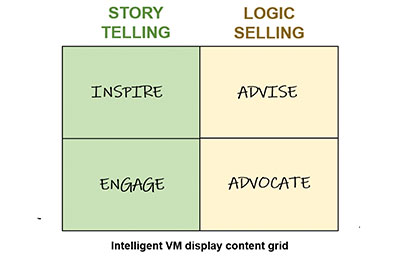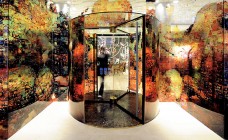Understanding the Business of Design in Retail
By Surender Gnanaolivu | July 09, 2018
Telling With Intel - Blending story-telling and logic selling in Intelligent VM
 The connected customer has the power to make informed decisions literally in their hands. With over 50% of shoppers testifying that they are influenced digitally when they buy across channels (Source: : Decoding Digital @ Retail: Winning the Omnichannel Consumer by BCG), visual merchandisers and marketers now need to be very precise and relevant when planning the content in displays targeted at the connected consumer. So, how does intelligent Visual Merchandising delivery this?
The connected customer has the power to make informed decisions literally in their hands. With over 50% of shoppers testifying that they are influenced digitally when they buy across channels (Source: : Decoding Digital @ Retail: Winning the Omnichannel Consumer by BCG), visual merchandisers and marketers now need to be very precise and relevant when planning the content in displays targeted at the connected consumer. So, how does intelligent Visual Merchandising delivery this?
It’s an established trend that Retail Experience Design has today become a multi-sensory design effort created with visual merchandisers, marketers, UX and UI designers huddling together. Brands endeavour to sell their equity with ‘Story Telling’ content to  appeal to the emotional side of the consumer augmented with rational ‘Logical Information’ content that offer compelling reasons to buy. The need for the combination of ‘Story and Logic’ content in store experiences has redefined visual merchandising as “The art & science of presenting a store and its offerings to sell stories and logic to inspire and influence the connected consumer to buy”.
appeal to the emotional side of the consumer augmented with rational ‘Logical Information’ content that offer compelling reasons to buy. The need for the combination of ‘Story and Logic’ content in store experiences has redefined visual merchandising as “The art & science of presenting a store and its offerings to sell stories and logic to inspire and influence the connected consumer to buy”.
STORY TELLING is an ancient art that entails ‘inspiring’ and ‘engaging’ people to emotionally connect with the subjects of the story.
Inspiring customer with the power of store telling in windows has made many iconic brands like Harrods and Macys world famous.  The role of Visual merchandising, which for ages has been the use of art and crafts, today has been nudged sharply to become intelligent with the need for humanizing consumer experience by adding technology to create inspirational story-telling. This is playing a key role in helping physical retail to stay the most preferred channel in mature retail markets that are experiencing the onslaught of online retail.
The role of Visual merchandising, which for ages has been the use of art and crafts, today has been nudged sharply to become intelligent with the need for humanizing consumer experience by adding technology to create inspirational story-telling. This is playing a key role in helping physical retail to stay the most preferred channel in mature retail markets that are experiencing the onslaught of online retail.
Engaging with the consumer, when story-telling, has given them power to make choices catering to personal tastes. Intelligent VM uses focal points to present opportunities for the shoppers to ‘play with the display’ and create personalized products or experiences. Many brands like Rebecca Minkoff, Nike and Adidas have led by integrating some extreme and immersive digital integration into their stores that enable customers to deeply engage with the brand and build a stronger bond with them.
LOGIC SELLING is a very important role of intelligent VM that enables the consumer to make well informed decisions. With the connected consumer accustomed to searching for information in the digital domain to be advised, the delivery of adequate information and reviews on product features and benefits has become a hygiene expectation. Thus, ‘Advise’ and ‘Advocate’ has been added to the role of intelligent visual merchandising in retail environments.
Today, VM touch points are expected to be a lot more intelligent than before to advise with interactive dialogues in the buying process. Multi-media is used by visual merchandising in collaboration with technology to deliver this need to deliver very precise advice for the buying decision. Car brands like Hyundai and Jaguar use a combination of info loaded digital screens and a tactile installation of paint and upholstery swatches to help consumers customize their cars.
The advocacy role of intelligent VM, called ‘social proofing’, is what potential consumers seek directly from existing consumers before making a purchase. Brands and retailers are integrating this in-store in their displays to enable consumers to be make ‘recommended’ decisions. Its but logical that Amazon books would use big data to predict consumer preferences by analysing online consumer ratings and speed of reading on Kindle data and use this in its intelligent visual merchandising by integrating star ratings on their shelves.
In conclusion, I can say assertively that today Intelligent Visual Merchandising has reimagined the art and science of this disciple by integrating design and data seamlessly to define, design and deploy very effective displays that attract and convert the connected customer. The skill of blending design with customer analytics, social media analytics, product features and tech tools has come to stay. The time has come for the new-age Visual Merchandiser to effectively use both sides of the brain to stay relevant to the omni-channel wave that is sweeping the retail world. Cheers!


_165_265.jpg)
_165_265.jpg)





Comments